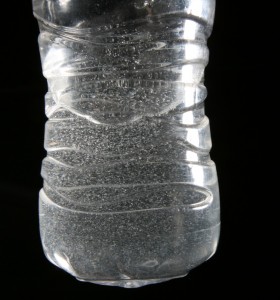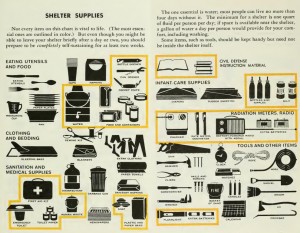Box of Epic Emergency
Having watched a TED talk on what to do in the case of a Nuclear Attack, I realised that I’m woefully under-prepared for some sort of major (motion picture worthy), disaster.
There could be a major plague, like 28 days later/I am legend, a nuclear attack (more likely from a Terrorist attack, not from a full out nuclear war), impeding asteroid impact, chemical, explosive, or biological terrorist attack. Or maybe it’ll be something more likely, such as an earthquake, fire, or flood. While I have the basic required equipment, and skills I would need to survive out in the wild, it would take me hours to assemble it all into something nice enough to throw into the back of the car, so that I and the family could drive out of harms way, or put into a backpack and run away.
As such, I have decided to create a ‘Box of Epic Emergency‘ (or possibly a bag).
The name comes from my Photographic ‘Box of Emergency‘. It was mean to say ‘Box of Emergency equipment’, however I ran out of room when writing it. That particular box contains various studio photography related equipment, like adaptors, duct tape, spare hot shoe flashes and other odds and ends.

Anyway, back to the Epic box.
The first thing it will need is some core, minimum items, with possibly another section of extra items. I might even have two copies. A box, in the car, and the a bag version in the house.
The core items would be those which would fit in a reasonably easy to carry container, and would be the most useful.
This is my current suggested list for the core pack :
- WD40
- Duct tape
- Multi-tool (pliers, knife, etc.. in 1)
- Blanket
- Tarp
- Rope(s)
- 1x 2L bottle of water (more if you can fit it)
- Iodine tablets (or other water purifiers)
- A 24hour ration pack (more if you can fit them)
- Hexamine stove (or equivalent)
- Fire lighter
- Dynamo powered torch
- Dynamo powered radio
- Some Pens
- Basic toiletries
- Medial supplies
- Basic utensils (knives, forks, cups)
- AA batteries (for things you pick up that aren’t hand powered)
- 500Gb or 1TB HDD
The extended version would likely be useful for longer term problems, and for more than one person, and would include the following :
- 5x 3L bottles of water (more if you can fit it).
- 3x 5 day ration packs (can be augmented with can food).
- More spare batteries (just in case).
- Powdered Milk
Explanation of the different items :
WD40 : WD40 is more useful than just compressed oil in a can. It can be used for everything from lubrication, and degreesing, to portable make-shift flamethrower, and even engine starter (esp for Diesel engines).
Duct tape : As they say for the ‘real mans toolbox’, if it doesn’t move and it should, use WD40, if it does move, and it shouldn’t, use duct tape. Some other uses of Duct tape include a make-shift bandage, emergency shoes, rope, for sealing windows and doors, or even to gag people.
Multi-tool : A multi-tool is one of those pliers, knife, screwdriver, and other things, all in one. You can cut up food, repair your gun, defend yourself, and even clean your finger nails with it. You can go for a swiss army knife as well, although they don’t include the ability to cut wires, or crush peoples noses with the pliers. You might also want to augment it by having an extra knife, and screw driver. Extra brownie points for getting an emergency rescue tool.
Blanket : A blanket can be used in a variety of situations. Whilst mainly used for keeping someone warm on the cold nights, it can also be soaked in water to provide protection against fires, protect against the harsh sun, used to help capture hysterical people/animals, and can also make the cold hard ground, not so cold, and not feel so hard.
Tarp : A tarpaulin, whilst seemingly similar to a blanket, has different uses, especially due to its water proof properties. They are great for making shelter under in the rain, and can be fashioned to collect rain water (hopefully the rain water isn’t contaminated), you fashion the tarp so it funnels the water into a bucket on one side. It also gives you shelter from the rain. If it’s not raining but the nights get cold enough, you can have a rock or something pull the tarp down towards its centre, causing the morning dew to pool into the middle.
You could also use the Tarp as your actual container, and should you need, you can wrap your other items in it to swim across a river. Although I wouldn’t suggest using one to create a makeshift boat, unless you were REALLY desperate.
Ropes : Ahh ropes, wires and string. If you haven’t gone to scouts (or something equivalent), then it is unlikely you’ll truly understand why ropes can be so fun and versatile. You can tie your tarp down to some nearby trees, secure some logs together, keep your car from falling apart, wire up a trap, and tie stuff down onto a trailer. I’m not even going to mention what you can do when you apply some rope, and the ability to tie knots, onto people.
Bottled Water : You don’t know where you’ll end up, and who’s tainted the supply, or even if there is any water there. You can go weeks without food, but only days without water (and only minutes without air). The standard rule of thumb is that you will need about 2 litres of water, per person, per day. The more water, the better.

Bleech, Iodine, or some other water disinfectant : First off, I highly recommend you boil all your water!
You have a few choices once your previously bottled water supply runs out. You can collect rain water, boil or treat the water, or even attempt to extract water from plants. Hopefully you were smart enough to keep within half a days walk of a water supply, be that a river, lake, or even hole in the ground.
What ever you do, DO NOT drink from that source of water directly. In a survival situation you should always assume the water is contaminated. You might find that some animals have died upstream, or the water is infected with giardia, Hepatitis, and various other bugs, bacteria, and viruses.
I will stress again, that you should boil your water before you drink it. Bringing water up to the boil for 10 seconds is enough to destroy all known bacteria (except for maybe Anthrax spores).
Why have a chemical disinfectant? Because, sometimes you don’t have the fuel to boil water, and it is always good to have extra options, plus they usually don’t take up much space.
Taken from http://www.survivaltopics.com/survival/water-purification-101/ :
Regular non-scented household chlorine bleach can be use to chemically treat water to make it safe to drink. Usually household chlorine bleach is 5.25% chlorine. Simply add two drops per quart (or litre) of water and let stand for at least half an hour. If the water is cloudy double the amount of chlorine and double the amount of time you let it stand. Be sure to splash the chlorine laden water all around your water container in order to disinfect everything the water comes in contact with.
A major problem with using chlorine bleach to disinfect water is that it has a short shelf life and so should be rotated from your survival gear every 3 months or so in order to keep at full strength.
A much beter alternative to chlorine bleach water disinfection is to use Calcium Hypochlorite. Survival Topics has an article on using Calcium Hypochlorite for Disinfecting Water that you should read if you are serious about the chemical disinfection of water.
There are a number of other uses for bleach, and iodine. Although most are for cleaning uses. Bleach is better at killing germs, while some Iodine supplements can help against radiation poisoning.
24hour ration pack : Whilst most people with military experience are familiar with rat packs, trying to actually get one can sometimes be hard. Thankfully various commercial versions are available at a number of outlets, and online, you can fairly easily make one up yourself, although it won’t have a FRED. Alternatively you can go all out.
An except of the contents of the old style ration pack.
http://www.mreinfo.com/international/australia/australian-cr1m.html
Beef & Vegetables (Dutch Style) – 250ml
Beef, Minced, With Spaghetti – 225ml
Freeze Dried Rice – 55g
Beverage, Powder, Sport, Lemon & Lime – 12g
Beverage, Powder, Sport, Orange 12g
Soup, Low Salt, Chicken Flavour – 30g
Biscuit, Shortbread – 35g
Chewing Gum, Juicy Fruit – pkt4
Curry Powder – 3.5g
Fruit Grains, (URC), Apricot – 15g
Fruit Spread, Peach – 26g
Fruit, Peaches, Diced, Canned – 140g
MB, Apricot & Coconut – 31.3g
Sauce, Tomato, Ketchup – 15g
Biscuit, Jam Sandwich Type 2 – 45g
FRED (Field Ration Eating Device)
If you want to make up your own, then here’s the contents of the New Zealand’s combat ration packs :
Breakfast
1 x 100 grm muesli cereal with milk powder.
Snacks
2 x choc bars
2 x muesli bars
2 x pkt sultanas
Lunch
1x instant noodles
1 x pkt cream crackers
1 x cheese spread
1 x fruit salad
Dinner : One of the following 300 grm meal packs, all include a 1 x 85 grm pack of instant noodles
mushroom risotto- vegetarian
chicken & pasta with vegetables
chicken teriyaki
beef & vegetables
lamb and mint gravybeef satay
Condiments
1 x salt sachet
2 x sugar sachet
2 x coffee sachets
2 x tea bags
1 x sports drink
1 x sweetened condensed milk
Total weight 1.2 Kilograms
Energy content per pack + 13,700 kj
Stove : You’ll need to boil your water, and cook your food. If you have access, then a hexamine stove can be great, the fuel lasts ages, and is quite safe, but sometimes is hard to get a hold of. More than likely you’ll have access to Kero, Methylated spirits, or even Petrol. Most people (at lease here in Australia) use a Trangia, which is a simple, yet effective Metho burner. Really desperate? You could hack up a coke can.
One note, if you did get a ration pack as mentioned above, then most are designed so that you heat a container of water with the main meal sachet inside. Once done you open the sachet and have a ready hot meal, plus some hot water for tea, coffee, instant noodles, or drinking water (after you’ve left it to cool).
Matches/lighter : What’s the point of having a stove if you can’t light the fuel to make a nice mug of hot chocolate? If you are serious then you’d already be carrying a fire stick, or Fire Steel, which you scrape some metal (like your car keys) across, to generate sparks that will set alight the fuel, or maybe the bark filings/tinder you have waiting in a nice pile. Just in case, you’ll probably want a butane lighter as well, especially one of those nice jet ones that can be used in windy conditions.
Run out of matches, and lost your fire stick?
[youtube]http://au.youtube.com/watch?v=ZYcBiEX9p6w[/youtube]
Dynamo powered torch : It’s likely that in a catastrophic emergency you will have limited to access to clean water, let alone electricity to recharge your batteries. The new range of hand cranked torches that use LED’s might not be as bright as a battery powered torch, and might be a bit bigger, but unless you are rough with it, they’ll last a lot longer. Still, don’t be afraid to throw in a battery powered torch just in case.
Dynamo powered radio : So you’ve managed to survive the earthquake , alien attack, or found out that like the other 2% of the population you are actually immune to the deadly virus. But now what?
Unless you are a super hero, it’s unlikely you’ll survive much on your own, I mean what happens when you get sick? Well hopefully any organised survival outposts will have radio transmitters, and while most cars will still have enough battery power, and fuel to let you listen for a couple of days, you can’t exactly stay very sheltered from the zombie horde when listening to the radio in the car. On a side note you might be a bit safer in a front end loader, or something you can use to go all carmageddon on their brain munching asses.
I should also mention that there’s two types of radio most people are use to, the AM/FM radio stations that you usually listen to music on, and the CB radios that truck drivers and the like use to communicate. Having a walkie-talkie/CB radio can be incredibly useful, when coordinating multiple people especially in the initial aftermath, and some will last a few days with spare batteries, although I’ve not yet found a solar, or hand powered version, but haven’t looked much.
Pens : You should always have a pen on you anyway, but imagine being stuck all alone, having found out the secret to the killing the Alien invaders, but can’t even write it down. Maybe you need to communicate through glass, sound proof doors. You can almost always find something to write on, even if it’s your hand, or clothes, but it’s much harder to write 2,000 words when it’s your own blood, or your trying to etch it into a tree.
Basic toiletries : Toothbrush, toothpaste, dental floss, razor blade, garrotting wire, if you particularly fussy you can bring along a mirror, and maybe some toilet paper, although don’t expect the paper to last long.
Medical Supplies : Bandages, band-aids, some disinfectant, super glue. Yes, I said super glue and it is amazing, you can use it to quickly seal wounds, stick your fingers together, and also fix a variety of other things. If things get particularly bad you might want some easy way out, maybe an excess of sleeping pills, and vodka or something?
HDD (Hard Disk Drive) : OK, so you might not be able to view the images on your hard drive when there’s no computers cause they all got fried by an Aliens EMP, or there’s no power as Zombies are lazy and not very good at running power stations, but that’s unlikely. Still, you should backup your data (My Documents, digital photos, etc), as it’s more likely your house will burn down, or your computer(s) will break, and you’ll loose it all. I don’t think I could forgive myself if I lost all 400GB worth of digital photos (I am a professional photographer).
Powdered Milk : So we’ve already noted that if you don’t have any water, then your dead, but having water on your breakfast cereals just isn’t the same. If you want you can stack up on long life milk, or sweetened condensed milk, but nothing beats the shelf life, nor ability to turn a 1litre bag of powder into more than 40litres of milk by just adding water.
Suggested reading :
Any of the other links in the text above.
http://www.survivaltopics.com/ – A great looking website (I confess to not haven’t looked at it all). There are some great articles that I would suggest printing out and putting in the Survival pack.
Got more suggested reading? Make a comment, let me know!

— Update [Nov 09] —
I’ve been doing a lot more reading on surviving a Nuclear attack, and didn’t realise there was so much information available, nor how relatively easy it is to survive the main blast and radiation exposure (assuming you are far enough away from it).
- http://www.schouwer-online.de/technik/zivilschutz_atomicattack.htm — SURVIVAL UNDER ATOMIC ATTACK. A great site, based on the book of the same name, which was created in 1950
- http://www.archive.org/details/falloutprotectio00unitrich — The Fallout Protection book created in the 1961 still has some interesting tips and tricks, which should be read BEFORE a Nuclear attack happens.
- http://en.wikipedia.org/wiki/Fallout_shelters — Information on Fallout shelters. Particularly interesting was the protection offered, the types of radiation, and the fact that if there is a serious nuclear attack then it may take up to 3 years before most of the lingering radiation has expired. Although you should be able to exit the shelter before then.
- http://shop.ebay.com.au/i.html?LH_AvailTo=15&_nkw=geiger+counter — You can also buy Geiger Counters online for USD$150-$300
– Update Aug 2010 –
Common Craft have made an awesome video explaining what you’ll need for an emergency kit. They’ve got some great advice!

Good job. I agree with you.